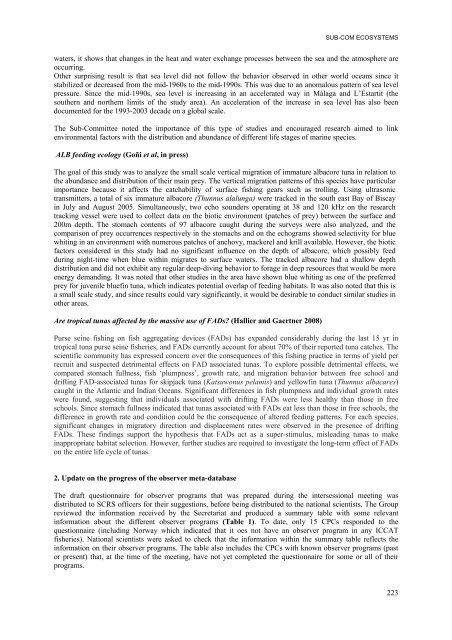REPORT OF THE STANDING COMMITTEE ON RESEARCH ... - Iccat
REPORT OF THE STANDING COMMITTEE ON RESEARCH ... - Iccat
REPORT OF THE STANDING COMMITTEE ON RESEARCH ... - Iccat
Create successful ePaper yourself
Turn your PDF publications into a flip-book with our unique Google optimized e-Paper software.
SUB-COM ECOSYSTEMSwaters, it shows that changes in the heat and water exchange processes between the sea and the atmosphere areoccurring.Other surprising result is that sea level did not follow the behavior observed in other world oceans since itstabilized or decreased from the mid-1960s to the mid-1990s. This was due to an anomalous pattern of sea levelpressure. Since the mid-1990s, sea level is increasing in an accelerated way in Málaga and L’Estartit (thesouthern and northern limits of the study area). An acceleration of the increase in sea level has also beendocumented for the 1993-2003 decade on a global scale.The Sub-Committee noted the importance of this type of studies and encouraged research aimed to linkenvironmental factors with the distribution and abundance of different life stages of marine species.ALB feeding ecology (Goñi et al, in press)The goal of this study was to analyze the small scale vertical migration of immature albacore tuna in relation tothe abundance and distribution of their main prey. The vertical migration patterns of this species have particularimportance because it affects the catchability of surface fishing gears such as trolling. Using ultrasonictransmitters, a total of six immature albacore (Thunnus alalunga) were tracked in the south east Bay of Biscayin July and August 2005. Simultaneously, two echo sounders operating at 38 and 120 kHz on the researchtracking vessel were used to collect data on the biotic environment (patches of prey) between the surface and200m depth. The stomach contents of 97 albacore caught during the surveys were also analyzed, and thecomparison of prey occurrences respectively in the stomachs and on the echograms showed selectivity for bluewhiting in an environment with numerous patches of anchovy, mackerel and krill available. However, the bioticfactors considered in this study had no significant influence on the depth of albacore, which possibly feedduring night-time when blue within migrates to surface waters. The tracked albacore had a shallow depthdistribution and did not exhibit any regular deep-diving behavior to forage in deep resources that would be moreenergy demanding. It was noted that other studies in the area have shown blue whiting as one of the preferredprey for juvenile bluefin tuna, which indicates potential overlap of feeding habitats. It was also noted that this isa small scale study, and since results could vary significantly, it would be desirable to conduct similar studies inother areas.Are tropical tunas affected by the massive use of FADs? (Hallier and Gaertner 2008)Purse seine fishing on fish aggregating devices (FADs) has expanded considerably during the last 15 yr intropical tuna purse seine fisheries, and FADs currently account for about 70% of their reported tuna catches. Thescientific community has expressed concern over the consequences of this fishing practice in terms of yield perrecruit and suspected detrimental effects on FAD associated tunas. To explore possible detrimental effects, wecompared stomach fullness, fish ‘plumpness’, growth rate, and migration behavior between free school anddrifting FAD-associated tunas for skipjack tuna (Katsuwonus pelamis) and yellowfin tuna (Thunnus albacares)caught in the Atlantic and Indian Oceans. Significant differences in fish plumpness and individual growth rateswere found, suggesting that individuals associated with drifting FADs were less healthy than those in freeschools. Since stomach fullness indicated that tunas associated with FADs eat less than those in free schools, thedifference in growth rate and condition could be the consequence of altered feeding patterns. For each species,significant changes in migratory direction and displacement rates were observed in the presence of driftingFADs. These findings support the hypothesis that FADs act as a super-stimulus, misleading tunas to makeinappropriate habitat selection. However, further studies are required to investigate the long-term effect of FADson the entire life cycle of tunas.2. Update on the progress of the observer meta-databaseThe draft questionnaire for observer programs that was prepared during the intersessional meeting wasdistributed to SCRS officers for their suggestions, before being distributed to the national scientists. The Groupreviewed the information received by the Secretariat and produced a summary table with some relevantinformation about the different observer programs (Table 1). To date, only 15 CPCs responded to thequestionnaire (including Norway which indicated that it oes not have an observer program in any ICCATfisheries). National scientists were asked to check that the information within the summary table reflects theinformation on their observer programs. The table also includes the CPCs with known observer programs (pastor present) that, at the time of the meeting, have not yet completed the questionnaire for some or all of theirprograms.223
















